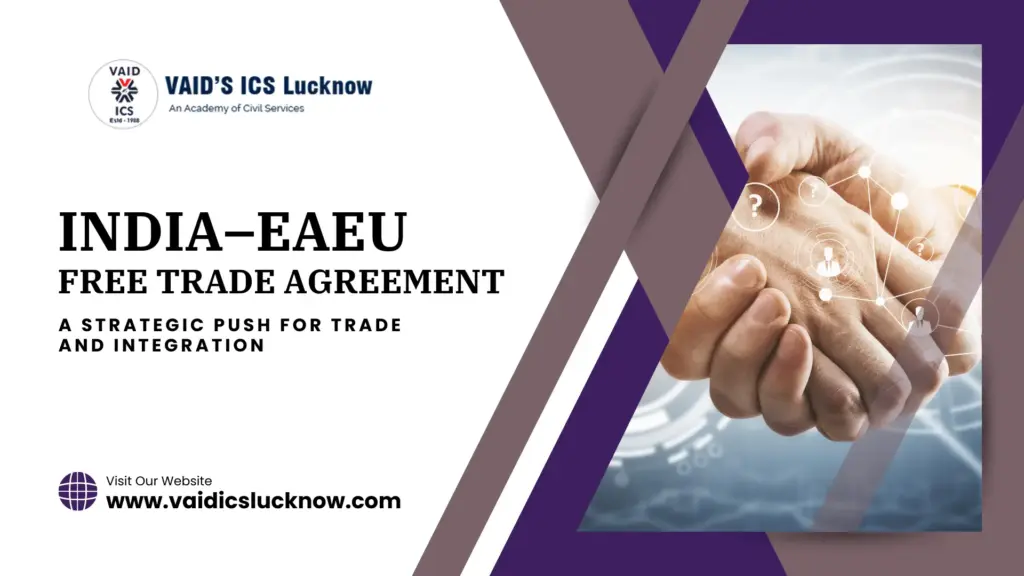August 21, 2025
India–EAEU Free Trade Agreement Negotiations Restart: A Strategic Push for Trade and Integration
Why in the News?
India and the Russia/led Eurasian Economic Union (EAEU) are back to negotiations of the Free Trade Agreement (FTA) after a long lapse. Negotiations have previously been put on hold with the United States under then President Trump imposing higher tariffs on Indian goods creating a disturbing trade bleak outlook in the country.
Through the signing of the Terms of Reference (ToR) to negotiations, India and the EAEU have now set the way forward, by building a structure in which negotiations will take place. India’s strategic need to diversify trade relations with non-traditional partners like the US and EU, and to respond to the growing dominance of non-market economies like China, indicates the renewal of this trade agreement. The renewal of this trade agreement is indicated by the strategic need of India to ensure that it diversifies its trade relations with countries that were not traditional partners like US and EU but also to react to increasing the dominance of non-market economies like China.
Interest Stage: Why Does This Matters?
The proposed FTA between India and the EAEU carries significant weight in today’s geopolitical and economic context:
- Rising bilateral trade: In 2024, the trade volume between India and the EAEU increased by 7%, reaching $69 billion compared to the previous year. Even more potential can be unlocked by an FTA across sectors
- Increased Economic Presence: The EAEU has a combined GDP of around US$6.5 trillion which opens a great potential among the Indian exporters and investors.
- Compensating the Uneven Playing Field: The FTA will help the Indian firms obtain easier accessibility in the Eurasian markets, especially as a means of offsetting Chinese economic predominance.
- Benefits to MSMEs: The agreement is set to bring particular benefits to MSMEs owing to the opening of export markets, reducing tariff costs, competitive advantages, etc.
- Strategic Diversification: These tensions with US and EU have prompted India to intensify its ties with Russia, Brazil, China, and other emerging groups in a bid to cut its loss on over- dependence on the West.
Consideration Stage: Key Features of the Proposed FTA
The India–EAEU Free Trade Agreement is not just about lowering tariffs but also about creating a framework for long-term cooperation. Its key objectives include:
- Unlocking Trade Potential
- Reducing tariff and non-tariff barriers.
- Facilitating smoother customs procedures.
- Promoting trade in both traditional and new sectors like IT, pharmaceuticals, agriculture, and engineering goods.
- Attracting Investments
- Encouraging bilateral investments in infrastructure, manufacturing, and services.
- Establishing a reliable environment to encourage long-term capital inflow.
- Strengthening Strategic Partnership
- Strengthening a long-term trade and economic partnership with a region vital for India’s energy and resource security.
- Offering stability against external shocks like sanctions or tariff wars.
- Enhancing Market Access
- Providing Indian businesses entry into EAEU markets, especially in areas like energy, agriculture, and pharmaceuticals.
- Positioning India as a counterweight to Chinese economic influence in Eurasia.
Decision Stage: Why the EAEU Matters for India
About the Eurasian Economic Union (EAEU)
- Established: 2015
- Headquarters: Moscow, Russia
- Members: Russia, Belarus, Armenia, Kazakhstan, Kyrgyzstan
- Purpose: To integrate economies, ensure free movement of goods, services, capital, and labor, and coordinate policies in key sectors like energy, transport, agriculture, and industry.
The EAEU functions as a strategic counterbalance to Western blocs such as the European Union and US-led trade systems. For India, engaging with this bloc is a step towards reshaping global economic alignments in its favor.
Benefits for India
- Trade Expansion: Gains from lower tariffs, reduced duties, and access to a $6.5 trillion economy.
- MSME Growth: Easier entry into Eurasian markets, particularly for textiles, engineering goods, and pharmaceuticals.
- Energy Security: Strengthening partnerships with Russia and Kazakhstan for oil, gas, and minerals.
- Strategic Leverage: Reducing overdependence on Western markets by diversifying trade routes.
- Regional Influence: Increasing India’s role in Eurasia’s economic architecture, countering China’s Belt and Road Initiative (BRI).
Challenges Ahead
While the India–EAEU FTA presents vast opportunities, it also comes with challenges:
- Geopolitical Complexities: Western sanctions on Russia could complicate trade and payments.
- Regulatory Challenges: Variations in standards, approvals, and logistics frameworks can obstruct seamless trade.
- Balancing Global Ties: India must carefully navigate relations with the US and EU while deepening Eurasian engagement.
- Domestic Concerns: Ensuring that sensitive sectors such as agriculture are protected from excessive foreign competition.
Future Outlook
India- EAEU FTA would have a potential to transform bilateral economic relations. It is not just to increase the trade statistics but also to redefine the position of India in the world economy system.
- For India, the move amplifies its engagement in multi-polar economic diplomacy.
- To the EAEU, it opens the entry to one of the fastest-growing consumer markets in the world.
- When it comes to global trade, it is an indication of the growing South South cooperation and decreased dependence on the conventional Western markets.
Conclusion
The reintroduction of the India-EAEU FTA negotiations would symbolize a moment of its own in the Indian trade policy. India will become a mediator on world economics because it can access the resources of the United States into a stable current market worth $6.5 trillion. More so, it will not be limited by western-based trade architecture.
The potential that accrues to trade, investment and strategic influence, especially in MSMEs and energy security could be enjoyed by India in the event that negotiations succeed and a deal is reached. This collaboration has the potential of coming up with a long-lasting solid India-EAEU economic corridor that will benefit the future.
September 1, 2025
August 27, 2025
August 25, 2025


